Skin Cancer Treatment
Early Detection Is Key
Skin cancer is the most common form of human cancers, affecting more than one million Americans every year.
There are many causes of skin cancer, and one in five Americans will develop skin cancer at some point in their lives. Left untreated, they can cause serious life-threatening issues – however, skin cancers are generally curable if caught early. People who have a history of having skin cancer are at a higher risk of developing a new skin cancer, which is why regular self-examination and doctor visits are imperative.
We provide skin cancer care and treatment for patients who need the most professional dermatologist Stuart FL has. Offering the highest standard of care for all our patients, we provide skin cancer detection services including regular check-ups, along with skin cancer management and prevention.
Our services include Mohs surgery which allows swift evaluation of any tissue suspected of being cancerous.
We provide state-of-the-art skin cancer care at our dermatology clinic in Stuart FL. From initial consultations to resolutions, we are with you every step of the way. The needs of our patients are always our primary concern, and we’ll make sure you are comfortable every step of the way.
One of the most common signs of skin cancer is changes in the shape or appearance of moles on your skin. We specialize in more removal, so you can rest assured that you are in safe hands. Our initial concern is to make sure you are not under threat of cancer, but with our highly skilled and professional team, we’ll be able to keep you looking great too.
We are the Stuart FL dermatologist that can help you with looking aesthetically pleasing while simultaneously striving to ensure that your health remains unaffected.
We provide the following skin cancer services to all our patients – should you have any special requirements, please let us know:
- Skin cancer surgery
- Mohs micrographic surgery
- Melanoma surgery
- Advanced excisional surgery
- Reconstructive surgery
- Laser and light-based skin cancer prevention and treatment
- Photodynamic therapy
- Skin cancer screening
- Melanoma management
- Skin care for organ transplant recipients
While there may seem to be a large variety of types of skin cancer, the vast majority of skin cancers are composed of three different types: basal cell carcinoma, squamous cell carcinoma and melanoma. The following is more in-depth information about each of these types.
Basal Cell Carcinoma
Basal cell carcinoma is the most prevalent form of skin cancer today. The body has a natural repair system in which new cells are created to replace worn out, old, or damaged cells. Should this system become damaged, cancerous cells can develop.
The most common way that damage is caused is through overexposure to UVB radiation, which is a natural radiation found in sunlight. Basal cells are found in deep in the epidermis, as are hair follicles and sweat ducts.
If damage to the repair system is caused, basal cell carcinomas will grow. These tumors grow slowly and do not often spread (a process known as metastasizing) and so can be treated if caught early enough.
The tumors do not all appear in the same way. Things to look out for include:
- Raised pink or pearly white bumps that have a pearly edge. There are often small but visible blood vessels.
- Areas that look like moles (with pigmentation to match) that again have pearly edges
- Sores that heal and reappear over and again
- Scars that are flat and scaly. They may have a waxy appearance and the edges may not be defined.
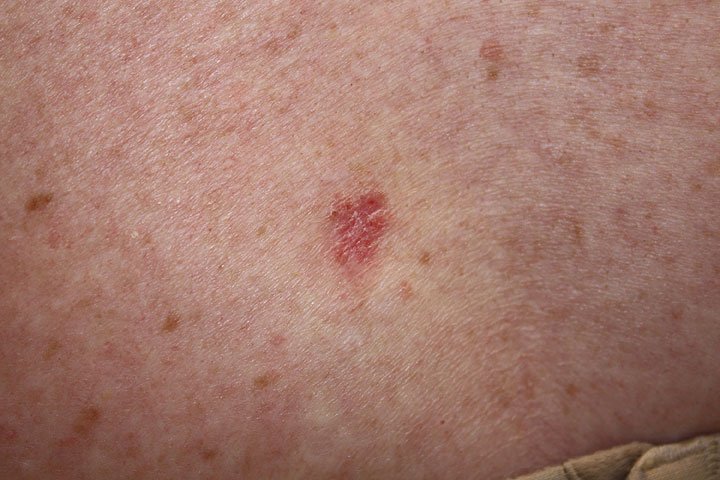
However, the cancer appears they all have one common connection – they will bleed with virtually no cause. The majority of basal cell carcinomas are found on the face and around the neck as these are the areas that are most often directly exposed to the sun.
While the sun may be the primary cause, UV radiation can be found from other sources, for example tanning beds and therapeutic radiation that may have been used to treat an unconnected condition. You will be further at risk if you have fair skin, and your chances of developing the cancer increases as you age.
Basal cell carcinomas are diagnosed via a biopsy in which part or all of the tumor is removed.
Squamous Cell Carcinoma
While basal cells are found deep within the skin, squamous cells are found in the surface of the epidermis. The associated carcinomas can develop anywhere on the body, including inside the mouth, but are most commonly found on the head and hands.
They appear on the skin as a crusted or scaly area with an inflamed red base which can be sensitive to touch. When viewed under a microscope the carcinomas look very similar to fish scales.
A small percentage of squamous cell carcinomas result in death, but to put that into perspective around a quarter of a million new cases are diagnosed every year. As with basal cell carcinomas, you are more at risk with fair skin and as you age.
Actinic keratoses can develop into these carcinomas. They appear as dry and scaly lesions in a range of colors from flesh-colored to reddish-brown or even yellow black.
Diagnosis is performed in the same way as basal cell carcinomas, via a biopsy in which either part or all of the tumor is removed.
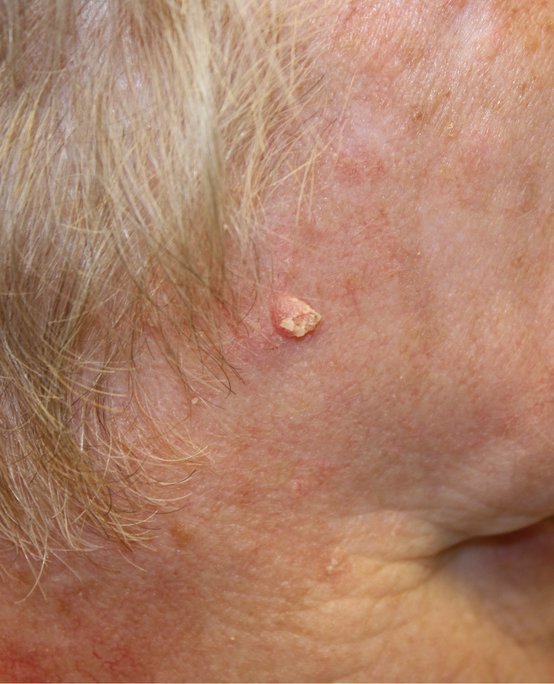
Both basal cell carcinomas and squamous cell carcinomas can be treated in a number of ways including the following:
Liquid nitrogen is used to freeze the tumor and cause it to detach from the body. It works best with basal cell carcinomas.
A small metal instrument, known as a curette, is used to scrape out the tumor. This is the most common method used by dermatologists. As the tumor is removed, an electric current is applied to the area which will kill any remaining cancer cells left in the tissue.
When large tumors are involved, this is the most suitable method for removing them. Cancerous tissue is removed surgically, and the area is examined with a microscope to ensure that no further cancerous cells remain. This allows a map of the skin to be built and helps to prevent healthy tissue being removed in addition to the cancerous cells.
Suitable for home application, prescription medicated creams stimulate the natural immune system of the body to fight against the cancer.
Some tumors are difficult to treat due to their location, their severity, or their persistence. Radiation therapy can be used to treat these tumors and help remove them.
This treatment involves the surgical removal of the tumor, which is followed by the area being stitched up.
Melanoma
Melanoma cancers spread extremely quickly and must therefore be caught and treated as soon as possible. If they reach the lymph system or the internal organs, they are much harder to remove – if it is at all possible.
Where other forms of skin cancer become more common as people age, melanomas can be found in much younger people. Overall, they are the least common form of cancer, but conversely, they are the most common form of cancer for people between the ages of 25 and 29. The cancer can run in families and is usually caused by overexposure to the sun from an early age.
Melanomas develop from melanocyte cells which are found in the bottom layer of the epidermis. Melanin is produced by these cells – this is the substance that determines skin pigmentation, as the more melanin that is present, the darker the skin will be.
Because of this, melanomas will most commonly appear as dark colored spots or patches on the skin, often giving the appearance of moles. To complicate matters, melanomas can grow inside moles, making them harder to spot.
Regular self-examinations of the skin should be conducted to make sure no new dark patches have appeared and that any existing moles remain healthy. If this kind of cancer is caught soon enough, it is treatable – but if left to spread or found too late, it can be deadly. Treatments can include surgical removal of the cancerous tissue, but as the cancer develops it may require radiation therapy or chemotherapy to be treated.
As with other skin cancers, melanoma is diagnosed with a biopsy.
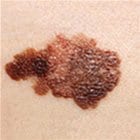
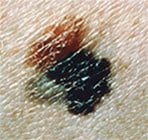
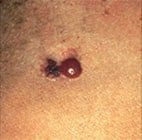
What To Look For
Skin cancers produce changes in the appearance and texture of your skin. If you notice these changes early enough, the cancer will be much easier to treat. There are several things to look for.
- New dark patches or moles that appear anywhere on your body, especially the palms of the hands or soles of the feet, or existing moles that begin to change shape, grow, itch, or bleed.
- Brown spots of varying sizes that contain darker specks, found anywhere on the body.
- Dark patches that appear on the fingers, toes, mouth, nose, or on the genitalia.
- Dome-shaped growths that may be pearly in color.
- Dark streaks that appear under the nails on the hands or feet.
- Sores that heal but continuously reappear.
- Scaly lesions that appear in clusters. They may be slow-growing and will appear pink or red in color.
If in doubt, the ABCDE method can be used. Devised by The American Academy of Dermatology, it is a guide that helps to assess if any skin issue may be cancerous in nature.
Asymmetry: The mole is not symmetrical – this does not only apply to shape, as one half may not match the other in size or color.
Border: The edges of healthy moles are clearly defined and regular. If the outline of the mole is irregular in shape, scalloped, or unclear, it may need treatment.
Color: The color of the mole varies in different areas and it is not a uniform color from one side to another.
Diameter: If the diameter of a mole is greater than 6 millimeters, it should be checked out. Smaller moles may also require diagnosis too.
Evolving: If a mole changes in size, shape, or color, or is significantly different from the other moles on your body, you should have it checked.
It is important that you have the area checked by a professional if any of the situations in the ABCDE list exist on your body. You may require a biopsy, and it may transpire that the patch or growth is not cancerous – but remember it is much easier to treat cancer if it is caught early.
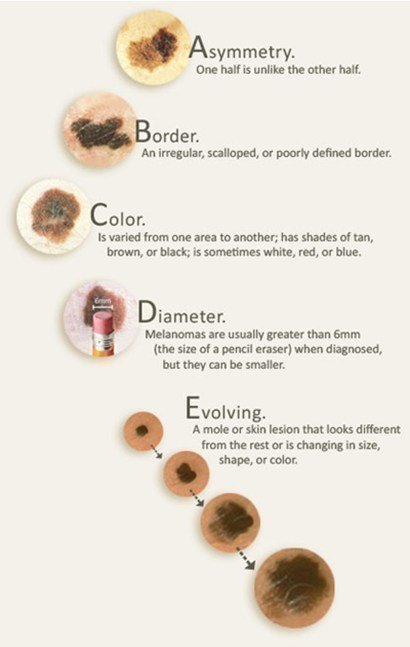
Prevention
Around 90% of skin cancers that are not melanomas are caused by UV radiation. The easiest way to lower your chance of developing this kind of cancer is to reduce your exposure to the sun.
Keep out of the sun when it is at its strongest, usually between 10am and 4pm, and make sure you cover up your body (including arms and legs) as much as possible. You can protect your head and face by wearing a wide-brimmed hat and sunglasses.
Using sunscreen is important all year round, as even if the sun is behind the clouds or the day is cool, the UV radiation can still get through. Choosing a sunscreen with a SPF of 15 or higher and using sun-blocks that protect against UVA and UVB rays will be best – these products are often labeled as giving “broad spectrum” protection.
Check your skin every month and schedule a regular skin examination with a professional every year. Early detection could save your life.
Need A Professional Opinion?
Set an appointment today.
